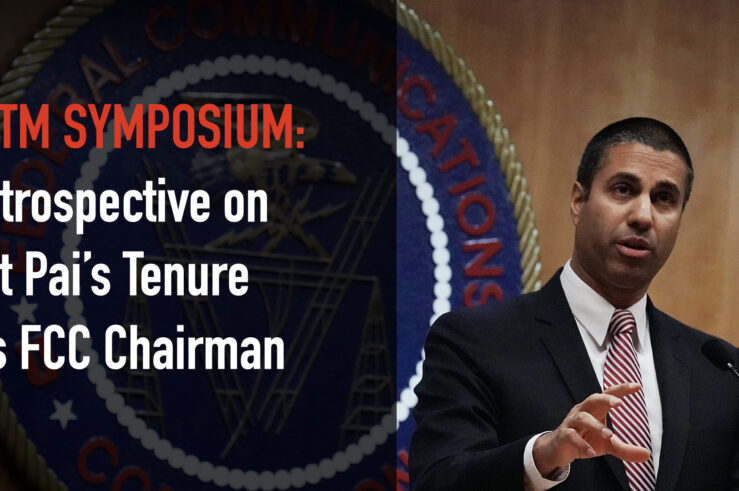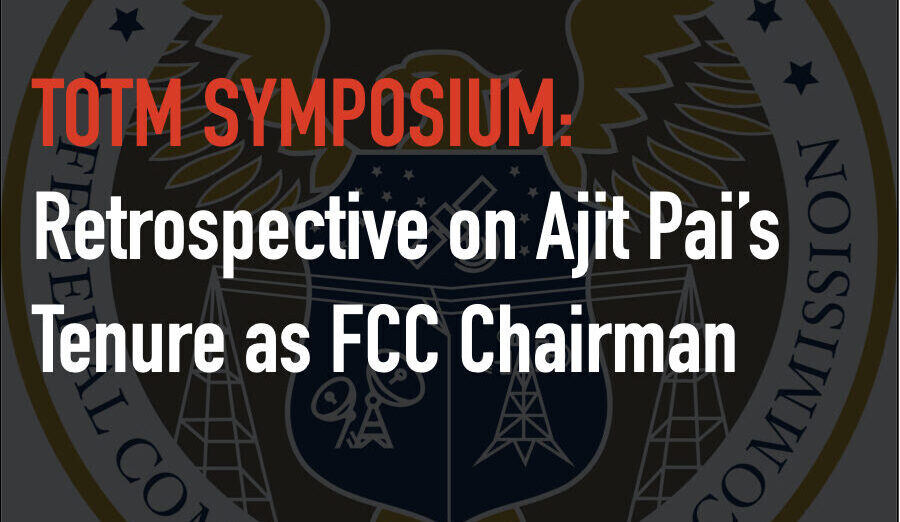
This article is a part of the Retrospective on Ajit Pai's Tenure as FCC Chairman symposium.

I am pleased to participate in this retrospective symposium regarding Ajit Pai’s tenure as Federal Communications Commission chairman. I have been closely involved in communications law and policy for nearly 45 years, and, as I’ve said several times since Chairman Pai announced his departure, he will leave as one of the most consequential leaders in the agency’s history. And, I should hastily add, consequential in a positive way, because it’s possible to be consequential in a not-so-positive way.
Chairman Pai’s leadership has been impactful in many different areas—for example, spectrum availability, media deregulation, and institutional reform, to name three—but in this tribute I will focus on his efforts regarding “net neutrality.” I use the quotes because the term has been used by many to mean many different things in many different contexts.
Within a year of becoming chairman, and with the support of fellow Republican commissioners Michael O’Rielly and Brendan Carr, Ajit Pai led the agency in reversing the public utility-like “net neutrality” regulation that had been imposed by the Obama FCC in February 2015 in what became known as the Title II Order. The Title II Order had classified internet service providers (ISPs) as “telecommunications carriers” subject to the same common-carrier regulatory regime imposed on monopolistic Ma Bell during most of the 20th century. While “forbearing” from imposing the full array of traditional common-carrier regulatory mandates, the Title II Order also subjected ISPs to sanctions if they violated an amorphous “general conduct standard,” which provided that ISPs could not “unreasonably” interfere with or disadvantage end users or edge providers like Google, Facebook, and the like.
The aptly styled Restoring Internet Freedom Order (RIF Order), adopted in December 2017, reversed nearly all of the Title II Order’s heavy-handed regulation of ISPs in favor of a light-touch regulatory regime. It was aptly named, because the RIF Order “restored” market “freedom” to internet access regulation that had mostly prevailed since the turn of the 21st century. It’s worth remembering that, in 1999, in opting not to require that newly emerging cable broadband providers be subjected to a public utility-style regime, Clinton-appointee FCC Chairman William Kennard declared: “[T]he alternative is to go to the telephone world…and just pick up this whole morass of regulation and dump it wholesale on the cable pipe. That is not good for America.” And worth recalling, too, that in 2002, the commission, under the leadership of Chairman Michael Powell, determined that “broadband services should exist in a minimal regulatory environment that promotes investment and innovation in a competitive market.”
It was this reliance on market freedom that was “restored” under Ajit Pai’s leadership. In an appearance at a Free State Foundation event in December 2016, barely a month before becoming chairman, then-Commissioner Pai declared: “It is time to fire up the weed whacker and remove those rules that are holding back investment, innovation, and job creation.” And he added: “Proof of market failure should guide the next commission’s consideration of new regulations.” True to his word, the weed whacker was used to cut down the public utility regime imposed on ISPs by his predecessor. And the lack of proof of any demonstrable market failure was at the core of the RIF Order’s reasoning.
It is true that, as a matter of law, the D.C. Circuit’s affirmance of the Restoring Internet Freedom Order in Mozilla v. FCC rested heavily on the application by the court of Chevron deference, just as it is true that Chevron deference played a central role in the affirmance of the Title II Order and the Brand X decision before that. And it would be disingenuous to suggest that, if a newly reconstituted Biden FCC reinstitutes a public utility-like regulatory regime for ISPs, that Chevron deference won’t once again play a central role in the appeal.
But optimist that I am, and focusing not on what possibly may be done as a matter of law, but on what ought to be done as a matter of policy, the “new” FCC should leave in place the RIF Order’s light-touch regulatory regime. In affirming most of the RIF Order in Mozilla, the D.C. Circuit agreed there was substantial evidence supporting the commission’s predictive judgment that reclassification of ISPs “away from public-utility style regulation” was “likely to increase ISP investment and output.” And the court agreed there was substantial evidence to support the commission’s position that such regulation is especially inapt for “a dynamic industry built on technological development and disruption.”
Indeed, the evidence has only become more substantial since the RIF Order’s adoption. Here are only a few factual snippets: According to CTIA, wireless-industry investment for 2019 grew to $29.1 billion, up from $27.4 billion in 2018 and $25.6 billion in 2017. USTelecom estimates that wireline broadband ISPs invested approximately $80 billion in network infrastructure in 2018, up more than $3.1 billion from $76.9 billion in 2017. And total investment most likely increased in 2019 for wireline ISPs like it did for wireless ISPs. Figures cited in the FCC’s 2020 Broadband Deployment Report indicate that fiber broadband networks reached an additional 6.5 million homes in 2019, a 16% increase over the prior year and the largest single-year increase ever.
Additionally, more Americans have access to broadband internet access services, and at ever higher speeds. According to an April 2020 report by USTelecom, for example, gigabit internet service is available to at least 85% of U.S. homes, compared to only 6% of U.S. homes three-and-a-half years ago. In an October 2020 blog post, Chairman Pai observed that “average download speeds for fixed broadband in the United States have doubled, increasing by over 99%” since the RIF Order was adopted. Ookla Speedtests similarly show significant gains in mobile wireless speeds, climbing to 47/10 Mbps in September 2020 compared to 27/8 Mbps in the first half of 2018.
More evidentiary support could be offered regarding the positive results that followed adoption of the RIF Order, and I assume in the coming year it will be. But the import of abandonment of public utility-like regulation of ISPs should be clear.
There is certainly much that Ajit Pai, the first-generation son of immigrants who came to America seeking opportunity in the freedom it offered, accomplished during his tenure. To my way of thinking, “Restoring Internet Freedom” ranks at—or at least near—the top of the list.



